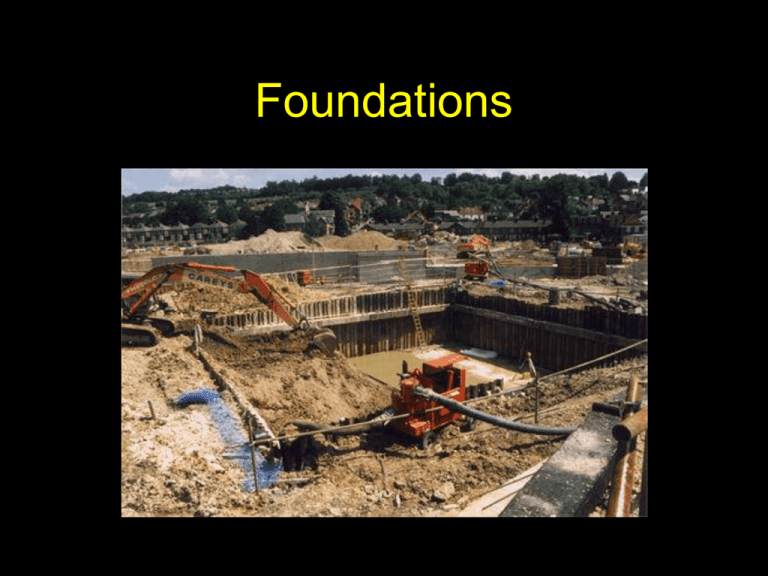Foundation Notes
advertisement

Foundations Foundations • Feature common to bridge and building structures • Deep vs. shallow • Safely transfer dead and live loads with acceptable levels of settlement Foundations Shallow Foundations • • • • – spread footings: column, combined, mat – strip footings: walls placed on undisturbed or well-compacted soil below frost line consider effects of groundwater typically reinforced or plain concrete Foundations Deep Foundations • Piles – driven or drilled – bearing capacity from end-bearing or skin friction: usually combination of both – driven plum or battered (1:6 to 1:3) – driven to attain minimum tip elevation or required resistance in blows per foot (bpf) Foundations Piles • Types – timber piles – precast/prestressed concrete piles – cast-in-place concrete – steel H-piles – steel pipe piles – composite – minipiles or micro piles Foundations Pile Driving • Equipment – mobile crane (usually crawler) – leads: fixed or swinging – hammer, helmet, & cushion – compressor (if air driven) – hydraulic unit (if vibratory) – steam plant (becoming obsolete) Foundations Pile Driving • Equipment – follower – mandrel • Pile accessories – point attachments – splices – pile to cap connections Foundations Pile Driving • Hammers – steam or air: singleacting, double-acting, differential – diesel hammer: singleacting (open end) or double-acting (closed end) – vibratory Pile Driving • Dynamic analysis - wave equation “WEAP” – based on wave propagation theory with input from the static analysis – provides relationship between pile capacity and driving resistance i.e.: equates capacity to blow counts – predicts pile driving stresses Pile Driving • Benefits of using wave equation – verify piles can be driven to required depth & capacity – determine minimum required pile section – avoid overstressing pile during driving – optimize cost Pile Driving • Dynamic testing - Pile Driving Analyzers (PDA) and CAPWAP – uses strain gauge & accelerometers to measure force & velocity (converts strain to force and acceleration to velocity) – field tests the driving hammer and system Pile Driving • Dynamic testing - Pile Driving Analyzers (PDA) and CAPWAP – cost effective method of optimizing the driving system and estimating static pile capacity – using CAPWAP, hammer blows can be analyzed to estimate skin friction, end bearing, dynamic damping factors, and soil stiffness Pile Driving Pile Load Test (static) • many tests have been used over the years to evaluate or confirm axial and lateral capacities • Quick pile load tests (QPLT) are most common • QPLT consists of constructing a reaction frame around the test pile • the frame is anchored to reaction piles • pile is incrementally loaded with an hydraulic jack Pile Driving Pile Driving Pile Load Test (static) • the test load is measured by a load cell • deformation is measured with dial gauges, wiremirror-scale, and surveying instruments • apply load in 10 to 15% increments, maintaining a 2½ minute interval • check deformation readings immediately before and after applying load Pile Driving Pile Load Test (static) • incrementally increase load until reaching 200% of the design load or until continuos jacking is required to maintain the test load • remove the load in 4 equal decrements • plot the load-settlement data using the Davisson method • the point where the load-settlement curve crosses the failure criterion is the failure load (Qf) Pile Driving Other Factors • soil setup or “freeze” - common in clays • relaxation - much less common, found in some silts or fine sand • restrike pile to verify strength gain or loss • 120 bpf is practical, safe, upper limit driving blow count • 200 to 240 bpf is practical refusal Pile Driving Inspection • position, plumb, or batter • check cushion; change as necessary • record blow counts • verify correct operation of hammer • check splices • check piles for damage • check for heave Pile Driving Driving Records • prepare a sketch of foundation to identify piles and order of installation • Drive records include: – pile ID and order of installation – ground elevation – cut-off elevation – tip elevation – final length – blows per foot (final foot recorded in bpi) – driving duration – location of splices Foundations Retaining Walls • gravity or cantilever • components – stem wall – horizontal base includes: toe, heel, & key – weep holes for drainage Foundations Temporary Support Structures and • sheeting w/wales and tie-backs • soldier beams (piles) w/lagging • pipe sleeves • tremie concrete Foundations Underpinning • remedial or precautionary • remedial adds foundation capacity to inadequately supported structures • precautionary - higher loads or changes in ground conditions Foundations Underpinning • Temporary supports – shores – needle beams – grillage • Pit underpinning - used for installing or extending foundation walls or footings • Pile underpinning & various other methods







